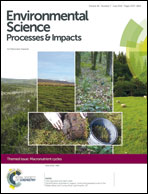UK catchment nutrient loads 1993–2003, a new approach using harmonised monitoring scheme data: temporal changes, geographical distribution, limiting nutrients and loads to coastal waters†
Abstract
The work provides robust estimates of nutrient loads (nitrate and phosphate) from all UK catchments: as required by the Water Framework Directive to monitor catchments' health, and to inform management of these environments. To calculate nutrient loads, data for nutrient concentrations and water flow are combined. In the UK, flow data are typically available at hourly intervals at more than 1300 gauging stations but concentration data are collected less frequently (roughly weekly) and at fewer locations (about 280). The sparseness of the concentration data limits the occasions for which load can be calculated, so a mathematical model was derived which was used to interpolate the concentrations between measurements. The model's parameters provide useful information about the annual nutrient concentration cycles within any catchment, and permitted improved estimates of both the annual loads of N and P, and of the N : P ratios, from mainland UK catchments. Data from 1993–2003 showed nitrate loads from UK catchments were generally constant, while orthophosphate loads generally declined. N : P ratios suggested that most catchments in the north and west of the UK were potentially P-limited although a few were potentially N-limited, while many in central and eastern UK oscillated seasonally between N and P limitation. Knowledge of the nutrient which is potentially limiting to biological productivity is a key factor for management of a catchment's nutrient loads. Calculations of nutrient export loads to coastal regions showed that UK catchments contributed only about 16.5% of total fluvial loads of nitrate to the North Sea, or about 3% of the total N loads when inputs from the Atlantic were included. Orthophosphate loads from the UK catchments into the North Sea were only 1.7% of the total P inputs from rivers and the Atlantic but did not include riverine inputs of P adsorbed to particles.

- This article is part of the themed collection: Macronutrient Cycles

 Please wait while we load your content...
Please wait while we load your content...